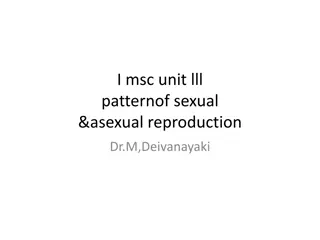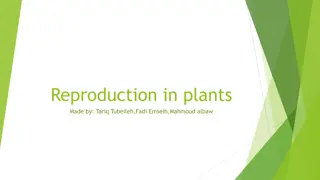Understanding Cell Growth and Reproduction: A Comprehensive Overview
Explore the intricate process of cell division through stages like Interphase, Mitosis, and Cytokinesis. Learn about the crucial phases such as Prophase, Metaphase, and Anaphase, each playing a significant role in the reproduction of cells. Understand the purpose and importance of the cell cycle in maintaining cellular functions and ensuring proper growth and repair processes.
Download Presentation

Please find below an Image/Link to download the presentation.
The content on the website is provided AS IS for your information and personal use only. It may not be sold, licensed, or shared on other websites without obtaining consent from the author. Download presentation by click this link. If you encounter any issues during the download, it is possible that the publisher has removed the file from their server.
E N D
Presentation Transcript
EOC Review Biology 2017
Standard 1.2.2 Grow and Reproduction of Cells 5/01/17 Day 06
Bellringer Explain the purpose of cell division. 1. Describe the four parts of the cell cycle. 2.
Cell Cycle The Cell Cycle describes the life of a cell from birth to death There are three main parts of the cycle: Interphase-Normal cell activities; broken up into 3 parts Mitosis-The process of cell division (1 cell becomes 2!) Cytokinesis-The division of the organelles and cytoplasm following mitosis
Interphase G1 phase (Gap/Growth 1)-Period of cell growth Cells can remain in the G1 phase indefinitely Called G0 S phase (Synthesis)-Period when DNA replication occurs Once a cell copies its DNA, it must divide S phase allows daughter cells to have exact copy of parent DNA after division! G2 phase (Gap/Growth 2)-Cell growth and preparation for Mitosis
Mitosis: Overview Mitosis is a form of asexual reproduction-means only 1 organism required Occurs in response to the body s need for growth and repair 4 stages of mitosis: Prophase, Metaphase, Anaphase, Telophase
Mitosis: Prophase What Happens? Nuclear membrane dissolves Chromatin condenses into chromosomes Chromatin: uncondensed DNA (looks like spaghetti) Chromosome: condensed DNA (looks like X s) Centrioles move to opposite ends of the cell Spindle forms and spindle fibers extend from one side to the other
Mitosis: Metaphase What Happens? Centromeres (middle of chromosome) attach to spindle fibers Chromosomes are pulled to the middle of the cell
Mitosis: Anaphase What Happens? Spindle fibers pull chromosomes apart Each sister chromatid moves toward opposite end of the cell
Mitosis: Telophase What Happens? Nuclear membrane reforms Spindle fibers disappear Animal Cells: Cell membrane pinches Plant Cells: New cell wall begins to form
Cytokinesis The cell cycle ends with cytokinesis the division of the cytoplasm Accompanies mitosis This means one cell has divided into two cells, and those two cells can continue with their own independent cell cycles!
Cancer Sometimes errors in the cell cycle can lead to cancer- Errors can be genetic or due to an environmental toxin Internal regulation error followed by external; cells cannot feel their neighbors, and thus begin uncontrolled division Lack density dependence (tumor) and anchorage dependence (metastasized cancer cells)
Things to Know: Outline the cell cycle Growth1, Synthesis, Growth2, Mitosis, and Cytokinesis. Recognize mitosis as a part of asexual reproduction. Organize diagrams of mitotic phases and describe what is occurring throughout the process.
Video Review Mitosis (The Amoeba Sisters) The Cell Cycle and Cancer (The Amoeba Sisters)
Standard 2.1.1 and 2.1.4 Nutrient Cycles and Population Graphs 5/2/17 Day 07
Bellringer Draw a diagram that illustrates either the nitrogen or carbon cycle. 1.
Carbon Cycle Carbon Cycle: Photosynthesis: Moves Carbon from inorganic carbon dioxide to organic glucose (carbon fixation) Cellular Respiration: Moves carbon from organic glucose to inorganic carbon dioxide (and releases stored energy for organisms) Decomposition: Moves carbon in living organisms to organic matter in soil (bacteria, fungi) Climate Change: Burning of fossil fuels and other human activities increase the amount of carbon dioxide in the atmosphere faster than photosynthetic organisms can respond; leads to global climate change
Nitrogen Cycle Nitrogen Fixing Bacteria: Convert nitrogen in atmosphere (as N2) to an organic form that plants can absorb through their roots (nitrates/nitrites). Nitrogen is now available to plants (and animals, through the food chain) to be used in the production of proteins and nucleic acids (DNA and RNA)
Climate Change Factors that influence climate: Greenhouse Effect Human impact on atmospheric CO2 Natural environmental processes Volcanic eruption Other geological processes
Energy Pyramids Energy Pyramids Energy is transferred up the pyramid, to higher trophic levels, as organisms are eaten Efficiency: 10% of energy is transferred with each trophic level. Source of energy: the Sun Radiant Energy (Sun) is converted to Chemical Energy by photosynthetic organisms and stored in chemical compounds of organic matter.
Population Growth Factors that limit population growth: Food availability Climate Water Territory Be able to identify the carrying capacity on a graph
Population Graphs Interpret Human Population Graph Influencing Factors Historical Changes Birth and Death Rates Population Size Population Density Resource Use on Environment Effect of disease on ecosystem balance Examples: AIDS, influenza, tuberculosis, Dutch Elm Disease, Pfiesteria
Standard 2.1.2 Survival and Reproductive Success 5/3/17 Day 8
Bellringer 1. Provide an example of each of the following: Behavioral Adaptation Structural Adaptation Reproductive Adaptation
SURVIVAL AND REPRODUCTIVE SUCCESS Adaptation-Any trait an organism acquires over time that helps it survive in its environment Can be structural, behavioral, or reproductive Structural-Physical features an organism has that help it survive Behavioral-Something an organism does to help it survive Reproductive-An organism chooses the correct mate to reproduce and raise offspring
ADAPTATIONS Transport and Excretion-Organisms maintain balance; move nutrients into cells and waste out In plants: Vascular and nonvascular Vascular Plants Nonvascular Plants Vascular tissue contains special cells for transport of water and nutrients Lack of roots and stems means plants must take water directly through their cells
ADAPTATIONS Respiration-organisms take in and release gases (we will discuss more later) Nutrition-feeding adaptations that allow organisms to get nutrition Autotrophic Heterotrophic Organisms that gain energy through making their own food (ex. Plants) Organisms that gain energy through eating their food (ex. Us!!)
ADAPTATIONS Reproduction, Growth, and Development-Organisms have adaptations to distribute their population Sexual Reproduction involving sex (needs a male and female) Asexual Reproduction without sex (can be 1 organism) Example: Seeds have a hard protective coating that allows them to survive some harsh conditions; some are small/prickly to allow transport
BEHAVIORAL ADAPTATIONS Behavioral adaptations can be innate or learned Innate= hard-wired; you are born knowing how to do this Learned=learned behavior either by interacting with the world or being taught!
INNATE BEHAVIORS Suckling-Babies are born knowing how suckle; adaptation allows them to be nourished Taxes/Taxis-movement of an organism in response to a stimulus (ex. Light or food) Migration-seasonal movement of animals in response to resource availability
LEARNED BEHAVIORS Habituation-an animal stops responding to a stimulus after too much exposure Imprinting-Baby recognizes something as parent/objet of trust Classical conditioning-Learning a new behavior through association (ex. Pavlov s dog) Trial and Error-Animal associates behaviors with the consequences they produce
Standard 2.1.3 Relationships between Organisms 05/04/17 Day 09
Bellringer Explain what happens to the population of population of rabbits (prey) as the population of fox (predator) increases? Population of Fox Decreases?
RELATIONSHIPS IN COMMUNITIES Predator/Prey-one organism hunts and kills another organism for food Ex. The lion (predator) hunts the gazelle (prey) Competition-two organisms compete over a common resource (food, territory, etc.)
Not all interactions among organisms involve eating each other Symbiosis = organisms living together 3 Types of symbiotic relationships Mutualism Commensalism Parasitism
Mutualism Mutualism = benefits both organisms in relationship https://www.youtube.com/watch?v=Xm2qdxVVRm4
Commensalism Commensalism = one organism benefits and the other is unaffected Note: There is debate that commensalism is just early mutualism! Maybe we don t understand all the benefits?
Parasitism Parasitism = one organism benefits and the other is harmed PARASITES (like viruses) don t immediatelykill host use it first sometimes kill it later!
ORGANISM INTERACTIONS Communication within society using pheromones-bees, ants, and wasps! Ex. Ants use pheromones to determine family members, to summon for attack/defense, and even to warn other ants when they are squashed Ex. Bees use pheromones to communicate and maintain organization in their colony
ORGANISM INTERACTIONS Courtship Dances-animals sometimes have rituals (may be a dance, vocalization, or display of beauty/power) in order to select a reproductive partner
ORGANISM INTERACTIONS TerritorialDefense-animals may defend their territory against other organisms, in or outside of their species Ex. Male fighting fish will build a nest and maintain that territory during breeding season, acting particularly defensive against other males
PREDATOR/PREY RELATIONSHIPS What happens to prey populations as prey increases? Decreases?
Quiz 1.2.2 / 2.1.1 / 2.1.4 / 2.1.2 / 2.1.3 05/05/17 Day 10























